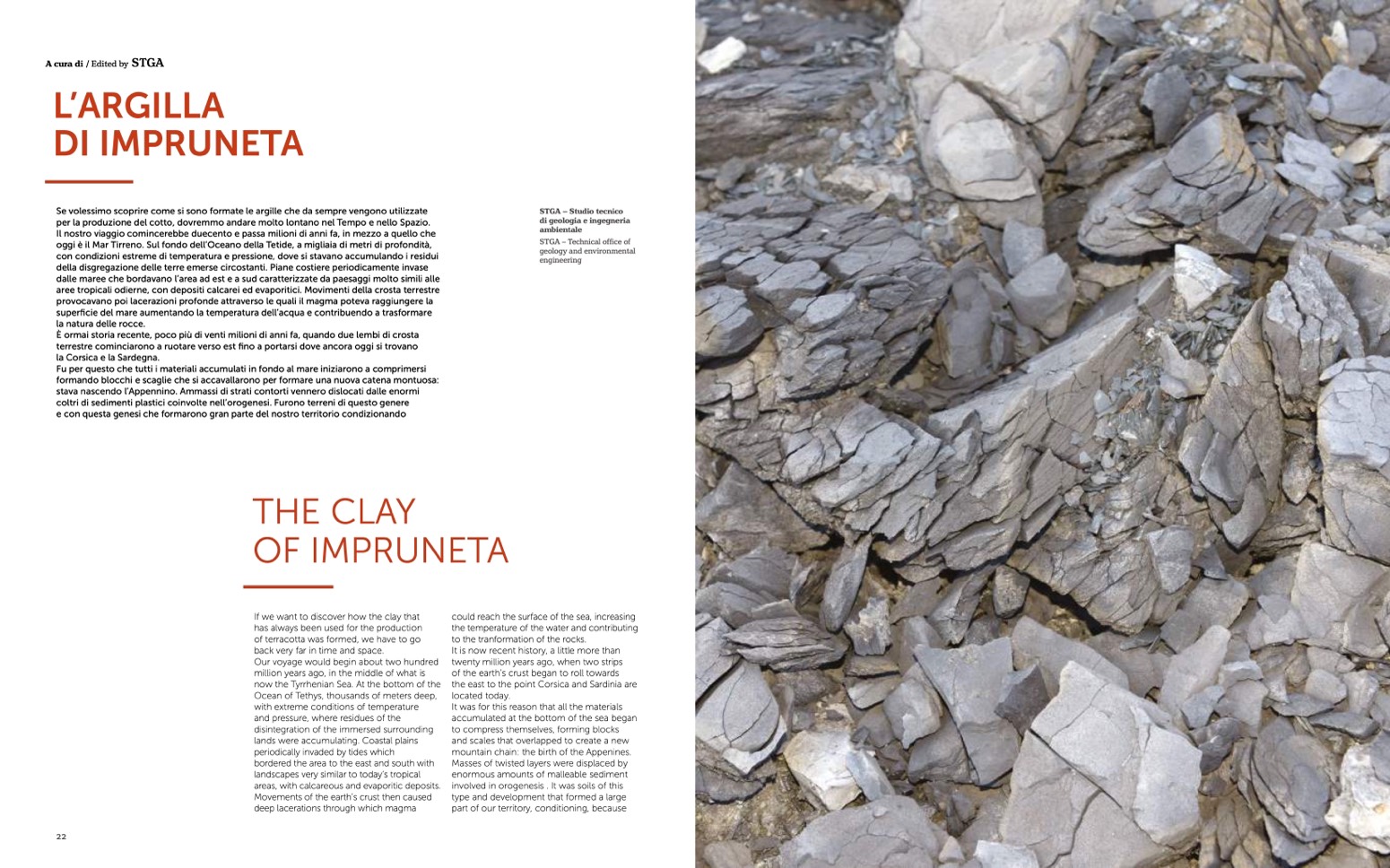
A cura di / Edited by
STGA
L’ARGILLA
DI IMPRUNETA
Se volessimo scoprire come si sono formate le argille che da sempre vengono utilizzate
per la produzione del cotto, dovremmo andare molto lontano nel Tempo e nello Spazio.
Il nostro viaggio comincerebbe duecento e passa milioni di anni fa, in mezzo a quello che
oggi è il Mar Tirreno. Sul fondo dell’Oceano della Tetide, a migliaia di metri di profondità,
con condizioni estreme di temperatura e pressione, dove si stavano accumulando i residui
della disgregazione delle terre emerse circostanti. Piane costiere periodicamente invase
dalle maree che bordavano l’area ad est e a sud caratterizzate da paesaggi molto simili alle
aree tropicali odierne, con depositi calcarei ed evaporitici. Movimenti della crosta terrestre
provocavano poi lacerazioni profonde attraverso le quali il magma poteva raggiungere la
superficie del mare aumentando la temperatura dell’acqua e contribuendo a trasformare
la natura delle rocce.
È ormai storia recente, poco più di venti milioni di anni fa, quando due lembi di crosta
terrestre cominciarono a ruotare verso est fino a portarsi dove ancora oggi si trovano
la Corsica e la Sardegna.
Fu per questo che tutti i materiali accumulati in fondo al mare iniziarono a comprimersi
formando blocchi e scaglie che si accavallarono per formare una nuova catena montuosa:
stava nascendo l’Appennino. Ammassi di strati contorti vennero dislocati dalle enormi
coltri di sedimenti plastici coinvolte nell’orogenesi. Furono terreni di questo genere
e con questa genesi che formarono gran parte del nostro territorio condizionando
THE CLAY
OF IMPRUNETA
STGA – Studio tecnico
di geologia e ingegneria
ambientale
STGA – Technical office of
geology and environmental
engineering
22
23
If we want to discover how the clay that
has always been used for the production
of terracotta was formed, we have to go
back very far in time and space.
Our voyage would begin about two hundred
million years ago, in the middle of what is
now the Tyrrhenian Sea. At the bottom of the
Ocean of Tethys, thousands of meters deep,
with extreme conditions of temperature
and pressure, where residues of the
disintegration of the immersed surrounding
lands were accumulating. Coastal plains
periodically invaded by tides which
bordered the area to the east and south with
landscapes very similar to today’s tropical
areas, with calcareous and evaporitic deposits.
Movements of the earth’s crust then caused
deep lacerations through which magma
could reach the surface of the sea, increasing
the temperature of the water and contributing
to the tranformation of the rocks.
It is now recent history, a little more than
twenty million years ago, when two strips
of the earth’s crust began to roll towards
the east to the point Corsica and Sardinia are
located today.
It was for this reason that all the materials
accumulated at the bottom of the sea began
to compress themselves, forming blocks
and scales that overlapped to create a new
mountain chain: the birth of the Appenines.
Masses of twisted layers were displaced by
enormous amounts of malleable sediment
involved in orogenesis . It was soils of this
type and development that formed a large
part of our territory, conditioning, because

